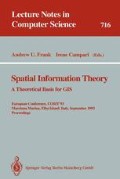Abstract
What is space? The term denotes primarily an ubiquitous natural resource. It also denotes a cultural resource, an artifact fashioned out of natural space by means of legal enactments and physical design. This paper identifies three varieties of cultural space which have their source in three different models for the nation: the family, the neighborhood, and the city. All three models are present and effective in every time and place. In certain places, however, and certain times, one is dominant. In the late nineteenth century the city (or civic) model predominated. In the first quarter of the present century the neighborhood model was ascendant. From the Great depression to the end of World War II it was the family model. Currently, the three models are very much in contention with each other for primacy. They present a challenge to both the planner and the GIS specialist. The planner is challenged to invent new settlement forms that adjust the rival spatial regimes to one another. The GIS specialist confronts the task of developing new ways of conceptualizing and capturing geographic data that are equal to the present day complexity and multi-dimensionality of present day cultural space.
Preview
Unable to display preview. Download preview PDF.
References
William Alonso: A theory of the urban land market. In Papers of the Regional Science Association, 6. Philadelphia: Wharton School of Finance, pp. 149–158 (1960)
American Institute of Architects, the Committee on Community Planning: Proceedings of the 58th Annual Convention of the American Institute of Architects, pp. 113–122 (1925)
Kenneth E. Boulding: Regions of time. Papers of the Regional Science Association, 57, pp. 19–32 (1985)
Walter Firey: Land use in central Boston. Cambridge Mass: Harvard University Press (1947)
Albert Guttenberg: “A Note on the Idea of Cycles in American Planning History”. Proceedings: Third National Conference on American Planning History. Cincinnati, Ohio. November 30–December 2 (1989)
R.M. Haig: Major economic factors in metropolitan growth and arrangement. In R.M. Haig and R. C. Mc Crae, eds. Regional survey of New York and its environs (1927)
Author information
Authors and Affiliations
Editor information
Rights and permissions
Copyright information
© 1993 Springer-Verlag Berlin Heidelberg
About this paper
Cite this paper
Guttenberg, A.Z. (1993). Land, space and spatial planning in three time regions. In: Frank, A.U., Campari, I. (eds) Spatial Information Theory A Theoretical Basis for GIS. COSIT 1993. Lecture Notes in Computer Science, vol 716. Springer, Berlin, Heidelberg. https://doi.org/10.1007/3-540-57207-4_19
Download citation
DOI: https://doi.org/10.1007/3-540-57207-4_19
Published:
Publisher Name: Springer, Berlin, Heidelberg
Print ISBN: 978-3-540-57207-7
Online ISBN: 978-3-540-47966-6
eBook Packages: Springer Book Archive

